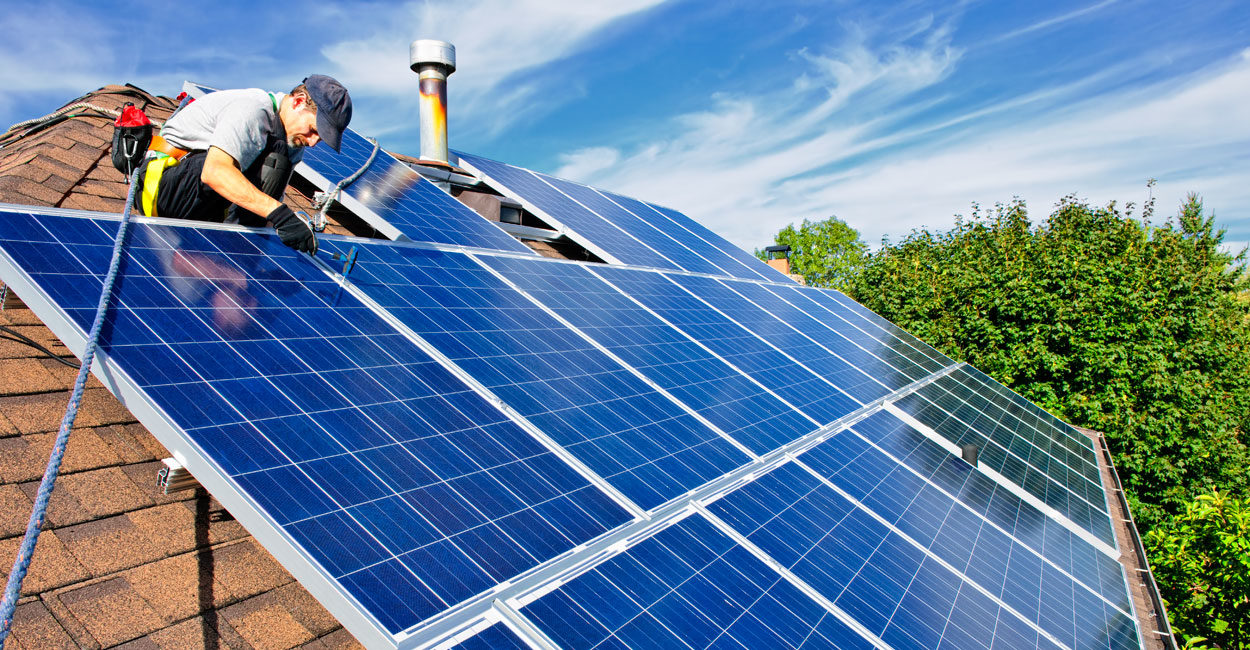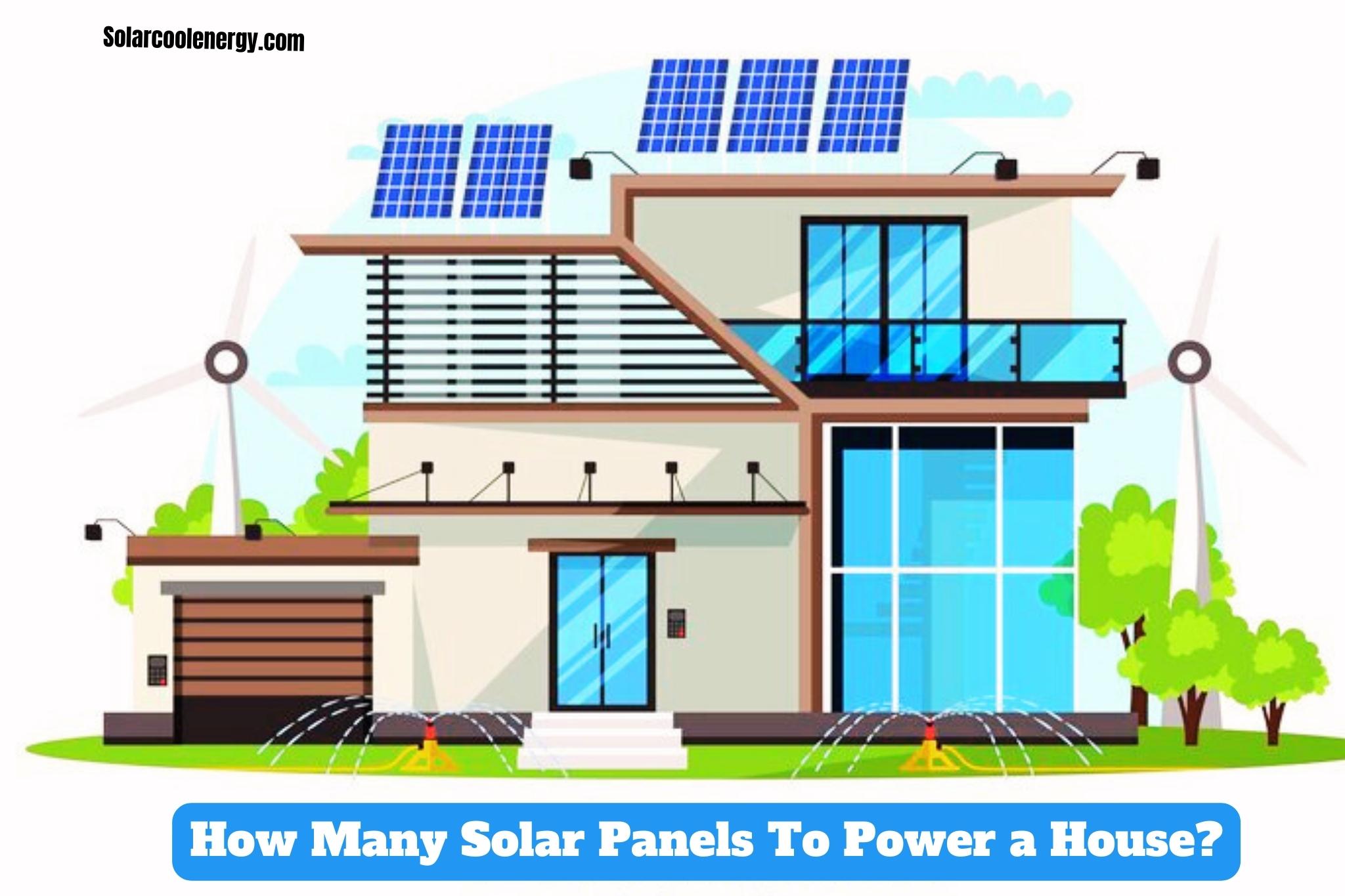Solar Panels To Power a House, the exact number needed depends on factors such as energy consumption, location, and panel efficiency. It is recommended to calculate your specific needs by considering your average energy usage and the peak hours of sunlight in your area.
Consulting with a professional can help determine the optimal number of solar panels required for your home.

Credit: Amazon
Assessing Household Electricity Use
Before determining how many solar panels are needed to power a house, it is essential to assess the household’s electricity usage. This assessment involves analyzing the monthly energy consumption, examining peaks in usage and seasonal variations, as well as identifying key appliances and systems that affect energy needs.
Review Of Monthly Energy Consumption
An effective way to understand the electricity needs of a home is to review the monthly energy consumption. By examining past utility bills, homeowners can gain insights into the average amount of electricity consumed each month.
It is important to note any significant variations in energy consumption throughout the year, as these fluctuations can impact the number of solar panels required. Whether it is due to changing weather patterns or seasonal activities, understanding these patterns will help in accurately estimating the solar panel needs.
Analyzing Peaks In Usage And Seasonal Variations
Another aspect to consider while assessing household electricity use is analyzing peaks in usage and seasonal variations. This analysis helps identify the times when the household consumes the most energy.
By studying the data, it is possible to discover trends such as higher energy consumption during certain hours of the day or specific months of the year. For example, if the household regularly experiences a spike in electricity usage during the summer months due to air conditioning, this information can be used to determine the number of solar panels needed to offset this peak demand.
Key Appliances And Systems That Affect Energy Needs
Identifying the key appliances and systems that significantly affect energy needs is crucial in determining the number of solar panels required to power a house. Some common energy-intensive appliances and systems include:
- Heating, ventilation, and air conditioning (HVAC) systems
- Refrigerators and freezers
- Washing machines and dryers
- Dishwashers
- Electric water heaters
- Electric stoves and ovens
- Home entertainment systems
By quantifying the electricity usage of these appliances and systems, homeowners can estimate the additional energy requirements and adjust the number of solar panels accordingly.
In conclusion, assessing household electricity use is a critical step in determining how many solar panels are needed to power a house. Reviewing monthly energy consumption, analyzing peaks in usage and seasonal variations, and identifying the key appliances and systems that affect energy needs provide valuable insights for an accurate estimation.

Credit: Youtube
Solar Panel Capacity Explained
When it comes to calculating how many solar panels are needed to power a house, it is essential to understand the concept of solar panel capacity. Solar panel capacity refers to the maximum power output that a solar panel can produce under specific conditions. In this section, we will delve into the different aspects of solar panel capacity to help you make an informed decision for your home’s energy needs.
Understanding Solar Panel Wattage
Solar panels are rated based on their wattage, which indicates the power they can generate. The wattage of a solar panel determines how much electricity it can produce when exposed to optimal sunlight conditions. Higher wattage panels provide more energy output, allowing you to generate more power for your household needs.
Differences In Solar Panel Types And Efficiencies
Not all solar panels are created equal. Different types of solar panels have varying efficiencies, which affect their power output. Monocrystalline and polycrystalline solar panels are the most common types available. Monocrystalline panels are known for their higher efficiency and sleek appearance, while polycrystalline panels are more cost-effective but slightly less efficient.
The Concept Of Peak Sun Hours
Peak sun hours refer to the period during the day when solar panels receive the maximum amount of sunlight. The duration of peak sun hours varies depending on the geographical location and time of year. Knowing the peak sun hours specific to your area is crucial for accurately calculating the number of solar panels needed to meet your energy requirements.
In conclusion, understanding solar panel capacity is vital for determining how many solar panels are necessary to power a house. Factors such as solar panel wattage, type, and efficiency, as well as peak sun hours, play significant roles in the overall capacity of your solar panel system. By considering these factors and consulting with a professional, you can ensure that your solar panel system effectively meets your household’s energy needs while maximizing efficiency and cost-effectiveness.
Breaking Down The Solar Energy Calculation
Estimating the number of solar panels required to power your house involves a step-by-step process. To begin with, you need to determine your average daily energy consumption in kilowatt-hours (kWh). This can be done by examining your past electricity bills or using an energy consumption monitor.
- Step 1: Calculate your average daily energy consumption in kilowatt-hours (kWh).
- Step 2: Determine the peak sun hours in your location, which represents the number of hours in a day when the sun’s intensity is sufficient for solar panel production.
- Step 3: Divide your average daily energy consumption (kWh) by the peak sun hours to find the number of kilowatts (kW) your solar panel system needs to generate each day.
- Step 4: Consider the efficiency of your solar panels, as not all sunlight is converted into usable electricity. Multiply the required kilowatts (kW) by the solar panel system efficiency to determine the minimum system size in kilowatts (kW).
- Step 5: Evaluate the wattage output of a single solar panel in ideal conditions. Divide the minimum system size in kilowatts (kW) by the wattage output per panel to estimate the number of solar panels needed.
Role Of System Size In Kw And Kwh In Calculations
The system size in kilowatts (kW) is a crucial factor in the solar energy calculation. It represents the amount of electricity that can be generated by the solar panel system in a given time period. By considering your average daily energy consumption in kilowatt-hours (kWh) and the peak sun hours in your location, you can determine the system size required to meet your energy needs.
Importance Of Location For Solar Potential
Your location plays a significant role in determining the solar potential of your house. Regions with more sunlight throughout the year will have a higher solar potential, allowing for greater energy generation. Understanding the peak sun hours in your location is essential for accurately estimating how many solar panels you need to power your house.
Choosing The Right Solar Panel Setup
Choosing the right solar panel setup is crucial when determining how many solar panels you need to power your house. Factors such as power usage, peak hours, and panel output should all be considered to ensure an efficient and cost-effective solution for your energy needs.
When it comes to harnessing solar energy to power your home, choosing the right solar panel setup is crucial. It not only determines the efficiency and effectiveness of your solar system but also plays a significant role in maximizing your energy savings. In this section, we will explore three key factors to consider when choosing the right solar panel setup: space considerations for panel installation, roof aspects, and grid-tied vs. off-grid options.
Space Considerations For Panel Installation
Before deciding on the number of solar panels needed to power your house, it’s essential to assess the available space for installation. Solar panels require adequate roof or ground space to capture sunlight and convert it into usable energy. Additionally, the location of your property can also impact the amount of sunlight received throughout the year.
Here are a few key points to keep in mind regarding space considerations for panel installation:
- Ensure that your roof has enough unobstructed space to accommodate the desired number of solar panels.
- Consider any shade that might affect the performance of the solar panels. Trees, nearby buildings, and other objects can cast shadows and reduce the overall energy output.
- Consult with a professional solar installer to assess the available space and determine the optimal solar panel layout for maximum efficiency.
Roof Aspects: Orientation, Inclination, And Load Capacity
The orientation, inclination, and load capacity of your roof are significant factors in determining the effectiveness of your solar panel setup. The orientation refers to the direction your roof faces in relation to the sun, while inclination represents the tilt angle of the solar panels.
Consider the following points concerning roof aspects:
- Optimal orientation for solar panels is typically south-facing in the northern hemisphere and north-facing in the southern hemisphere, as it maximizes the exposure to direct sunlight throughout the day.
- Inclination angle, also known as the tilt angle, should be adjusted based on your latitude to align the solar panels with the sun’s path.
- Ensure that your roof’s load capacity can support the weight of the solar panels. Consult a structural engineer or a professional solar installer to assess the load-bearing capacity.
Grid-tied Vs. Off-grid Options
When considering a solar panel setup, it’s important to decide whether you want a grid-tied or off-grid system. Each choice has its own set of benefits and drawbacks.
Grid-tied systems are connected to the local electrical grid, allowing you to sell excess energy back to the utility company. These systems often require less upfront investment and provide a consistent power supply.
Off-grid systems, on the other hand, operate independently of the grid and require energy storage solutions such as batteries. These systems offer complete energy independence but generally require larger solar panel installations and battery banks.
It’s essential to assess your energy needs, budget, and long-term goals to determine which option is best suited for your situation.
In conclusion, choosing the right solar panel setup involves considering space considerations, roof aspects, and the choice between grid-tied and off-grid options. By carefully evaluating these factors, you can ensure a solar system that meets your energy needs, maximizes efficiency, and helps you reduce your carbon footprint.

Credit: Youtube
Harnessing Efficiency To Reduce Solar Needs
Reduce your solar panel needs by harnessing efficiency. Discover how many solar panels are required to power your house and save energy in a sustainable way.
Energy-saving Home Upgrades And Their Impact
One of the key strategies in reducing the number of solar panels required to power a house is to focus on energy-saving home upgrades. By implementing these upgrades, you can significantly reduce your overall energy consumption, thus decreasing the number of solar panels needed.
The first step is to conduct an energy audit of your home to identify areas where energy is being wasted. This can include inefficient appliances, poor insulation, and outdated lighting fixtures. By replacing these items with energy-efficient alternatives, you can reduce your energy usage and lighten the load on your solar panels.
Here are a few energy-saving home upgrades that can have a significant impact:
- Installing LED Lighting: LED lights use up to 75% less energy than traditional incandescent bulbs. By upgrading your lighting fixtures to LEDs, you can cut down on your energy consumption and save money on your electricity bills.
- Upgrading Insulation: Proper insulation plays a crucial role in maintaining a comfortable indoor temperature and reducing the need for heating and cooling. By upgrading your insulation to meet or exceed local building codes, you can reduce thermal leaks and save energy.
- Replacing Old Appliances: Older appliances tend to consume more energy compared to newer, energy-efficient models. Consider replacing outdated appliances, such as refrigerators, washing machines, and air conditioners, with more energy-efficient options.
- Investing in Smart Thermostats: Smart thermostats allow you to control the temperature of your home remotely and optimize energy usage. By programming them to adjust settings based on your occupancy patterns, you can save energy without sacrificing comfort.
By implementing these upgrades, you can significantly reduce your overall energy consumption, resulting in a decreased reliance on solar panels.
Balancing Solar Production With Consumption Reduction
While upgrading your home to be more energy-efficient can help reduce the number of solar panels needed, it’s important to strike a balance between solar production and consumption reduction. Optimizing your energy consumption alone may not eliminate the need for additional solar panels.
Solar energy production depends on various factors, including the size of your solar array, the efficiency of your panels, and the available sunlight in your area. Therefore, it’s essential to evaluate your energy consumption patterns and compare it to the energy production capacity of your solar panels.
Here’s a simple approach to achieve this balance:
- Monitor your energy usage: Keep track of your daily energy consumption using smart meters or monitoring software. This will help you understand your energy needs and identify any areas where you can reduce consumption further.
- Evaluate solar production: Assess the energy production of your existing solar panels to determine if it aligns with your consumption. If the production exceeds your needs, you may consider resizing or expanding your solar array to maximize efficiency.
- Consider battery storage: If your solar panels are producing more energy than your immediate consumption, investing in battery storage can help capture and store the excess energy for later use. This can further optimize your solar production-consumption balance.
By regularly monitoring and assessing your energy consumption and solar production, you can strike an optimal balance between the two, ensuring efficient utilization of your solar panels.
Evaluating Potential For Future Expansion Of Solar Arrays
When considering how many solar panels you need to power your house, it’s crucial to evaluate the potential for future expansion of your solar arrays. This allows for scalability and ensures that your system can accommodate any additional energy needs in the future.
Here are a few factors to consider when evaluating the potential for future expansion:
- Roof space: Assess the available roof space to determine if it can accommodate additional solar panels in the future. Ensure that there are no shading issues or structural constraints that may hinder expansion.
- Solar panel compatibility: Consider the compatibility of your existing solar panels with potential future panel additions. Ensuring that they can be easily integrated and work efficiently in parallel will streamline the expansion process.
- Energy needs: Account for any anticipated increase in energy needs in the future due to household growth or the addition of energy-intensive appliances. This will help determine the number of additional solar panels required for the expansion.
- Inverter capacity: Evaluate the capacity of your solar panel inverters to handle the increased energy production from additional panels. Upgrading or adding inverters may be necessary to ensure optimal system performance.
By carefully considering these factors and designing your solar array with expansion in mind, you can future-proof your system and easily accommodate any increase in energy needs.

Credit: umasolar.com
Frequently Asked Questions Of How Many Solar Panels To Power A House
How Many Solar Panels Do I Need For 2000 Sq Ft Home?
For a 2000 sq ft home, you will need approximately 20-25 solar panels to generate enough electricity for your house. However, the exact number may vary based on factors such as location, energy consumption, and panel efficiency. It’s recommended to consult with a professional to accurately determine the number of panels required for your specific needs.
How Many Solar Panels Do I Need To Completely Power My House?
To completely power your house with solar panels, you need to consider factors such as your power usage, peak hours, and the wattage each panel produces. It is recommended to consult a professional to determine the exact number of panels you need.
How Many Solar Panels Do I Need For Full House?
To determine how many solar panels you need for your full house, consider factors such as your energy usage, peak hours of sunlight, and individual solar panel wattage. An appropriate evaluation is best achieved by consulting with a specialist.
Can 1 Solar Panels Power A Whole House?
Yes, it is possible to power your entire house with just one solar panel. People have even used larger solar panel systems to go completely off the grid and make their homes self-sustaining in terms of energy.
Conclusion
To determine how many solar panels you need to power your house, you should consider factors such as your average power usage, peak hours of energy production, and the wattage of each solar panel. It’s also important to consult with a professional to get an accurate quote and ensure you have enough space for the panels.
By harnessing solar energy, you can create a self-sustaining ecosystem and reduce your reliance on the grid. Start exploring solar panel options today and take a step towards a greener future.

